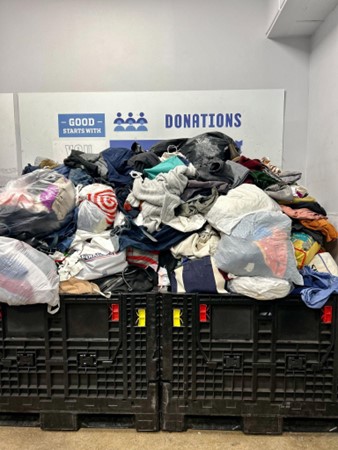Felicia Czochanski Bisaro
April is Earth Month, a time to put the spotlight on the most pressing issues facing our environment and make a commitment to action that mitigates them. Earth Month is the perfect excuse to celebrate the beauty of our planet and reflect on how we are impacting it in our daily lives. This year’s Earth Month theme is “Planet vs. Plastic,” which showcases the urgent need to reduce plastic pollution and plastic production. While individuals may feel limited in how they can support this goal (when compared to larger corporations who operate at scale), there is one easy habit you can start to incorporate into your routine that can help you and your family reduce plastic production waste by reducing plastic demand: shopping at Goodwill.
Sustainable Shopping
Shopping at Goodwill has many benefits, including affordable prices, hidden designer gems and the opportunity to shop in a more sustainable way than retail shopping. Shopping second-hand reduces everyone’s environmental footprint, including the usage of plastic waste.
At Goodwill, you can find a wide range of items, from clothing and shoes to picture frames, games, books and toys. Oftentimes, items at Goodwill will still be new with tags, which can be an incredible win because they will be just a fraction of retail price without contributing to additional retail demand. Each time you purchase something at Goodwill, you’re extending that item’s lifespan and diverting it from becoming pollution in landfills or incinerators.

The Circular Economy
Each year, Goodwill diverts more than 4.2 million pounds of waste from going to landfills. That’s because Goodwill promotes a circular economy, which focuses on keeping items in circulation longer so that resources aren’t wasted on recycling. It means items that are no longer serving the person who originally bought them donates them, and another person who will use them purchases them instead of buying something new at a retail store. This type of economy reduces the volume that manufacturers produce, making a difference over time.

Plastic Pollution
You’d be amazed by the number of plastics that can be found in everyday items, even clothing. Materials like polyester, acrylic, nylon and spandex shed microplastics, which, when going through the wash, get sucked into the water system and pollute streams, rivers and oceans. Conscientious shopping also involves ensuring you are purchasing quality materials — like linen, cotton and silk — which do not create the same plastic pollution.

As Earth Month wraps up, don’t forget to make conscientious choices all year long when it comes to more sustainable ways of shopping. The next time you find yourself needing clothes, furniture, electronics or toys, consider stopping by your favorite local Goodwill store to become part of the solution to fight plastic pollution and landfill waste. Together, we can make a difference, one thrifted treasure at a time!



